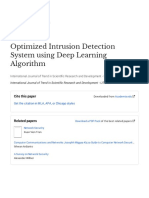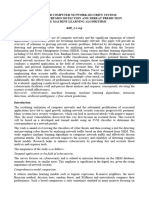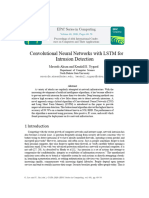0% found this document useful (0 votes)
69 views10 pagesNetwork Intrusion Detection Techniquesusing Machine Learning
This document discusses network intrusion detection techniques using machine learning. It provides an overview of network intrusion detection systems (NIDS) and how machine learning is being used to improve detection capabilities. NIDS monitor network traffic to detect attacks, while host-based intrusion detection systems monitor individual hosts. Machine learning techniques like supervised learning, unsupervised learning, and reinforced learning are being applied to NIDS to detect new and sophisticated attacks. Common machine learning algorithms discussed include decision trees, K-nearest neighbor, and neural networks. The document aims to provide a comprehensive overview of current research on machine learning-based NIDS.
Uploaded by
FASAKIN OLUWASEYICopyright
© © All Rights Reserved
We take content rights seriously. If you suspect this is your content, claim it here.
Available Formats
Download as PDF, TXT or read online on Scribd
0% found this document useful (0 votes)
69 views10 pagesNetwork Intrusion Detection Techniquesusing Machine Learning
This document discusses network intrusion detection techniques using machine learning. It provides an overview of network intrusion detection systems (NIDS) and how machine learning is being used to improve detection capabilities. NIDS monitor network traffic to detect attacks, while host-based intrusion detection systems monitor individual hosts. Machine learning techniques like supervised learning, unsupervised learning, and reinforced learning are being applied to NIDS to detect new and sophisticated attacks. Common machine learning algorithms discussed include decision trees, K-nearest neighbor, and neural networks. The document aims to provide a comprehensive overview of current research on machine learning-based NIDS.
Uploaded by
FASAKIN OLUWASEYICopyright
© © All Rights Reserved
We take content rights seriously. If you suspect this is your content, claim it here.
Available Formats
Download as PDF, TXT or read online on Scribd
/ 10























































































